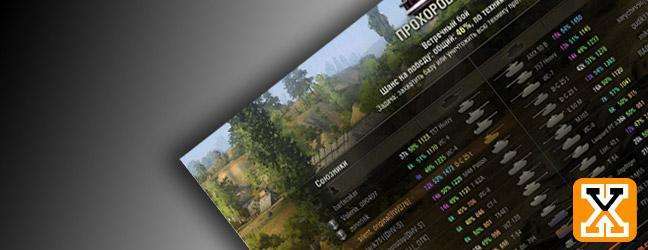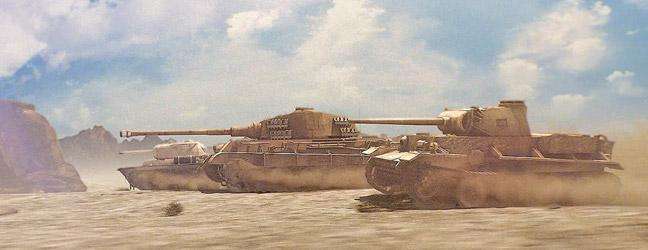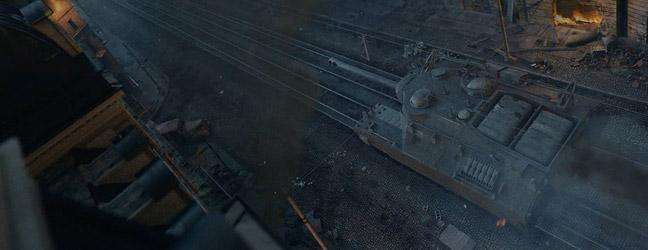ISU-152 "Beast Killer"
Дата: 07.06.2011 17:04:05
admin: 
ISU-152 — the soviet TD (tank destroyer) of WWII period. The designation ISU denotes that this self-propelled gun was designed on the basis of IS tank or IS-mount. The “I” letter in the designation was added to the designation “SU” (standard for the vehicles of this type) to differentiate this vehicle from SPG of the same caliber designed on another tank chassis. Numeric designation 152 denotes the caliber of the main canon.Works on ISU-152 were started by engineering department of the plant No. 100 in Chelyabinsk in June 1943. By this time it had become absolutely clear that tank KV-1s would be replaced in production with new perspective tank IS-1. Since 1942 Soviet military specialists criticized heavy tank KV-1 for insufficient weaponry (for the tank designed to break through the enemy lines), poor armor plating (considering power of 75 and 88 mm long-barreled cannons of the enemy tanks), and inconvenience for the crew and operational unreliability. The modification KV-1s improved mobility, operational reliability and convenience in exploitation essentially, but it caused the reduce of armor plating and the characteristics of this modification became closer to more material-intensive and much cheaper T-34 medium tank. But on its basis heavy assault self-propelled gun SU-152 were produced, the need of these vehicles in Soviet Army was doubtless. Excellent combat characteristics of SU-152 raised a question of designing its analog on the basis of the new tank which would replace in production the chassis of KV-1s.
The designing of ISU-152 was conducted under the guidance of Joseph Jakovlevich Kotin, main designer of the Soviet heavy tanks. Chef designer of ISU-152 was G.N. Moskvin. At the early stages the project of new TD was designated as IS-152. The first prototype of new heavy self-propelled assault gun was built in August 1943. It was a transitional version of SU-152 with its armored hull but with nodes and components designed to be mounted on the forthcoming SPG. Along with new heavies IS-1 and KV-85 this prototype was presented to the top Soviet leadership headed by Stalin in the Kremlin, Moscow in the late August 1943 (some sources claim other dates). Just before the demonstration all the crews (except for the driver-mechanics) were replaced with NKVD officers. The head of the Soviet Union showed a great interest in the new vehicle and even asked the crew personally how the problem of smoke elimination from the crew compartment was solved. And this episode had its anecdotic feature as the NKVD officer had no idea how to deal with this matter and kept silent. The situation was solved by the driver-mechanic who reported to Stalin that crew compartment was rigged with a special fan. Stalin was satisfied with the answer, got off the vehicle and congratulated the People’s Commissar for Tank Industry Malyshev with success.
During the hostilities these TD SPG were used in three different roles: as assault gun, as tank destroyer and as self-propelled howitzer.
This piece of memoirs describes ISU-152 acting as an assault gun: “Shortly before the German anti-tank gun began firing at Shermans standing under the arches (at night the gun was dragged to the top floor of the house north to the City hall). This gun damaged tracks of two Shermans. We had to do something urgently, otherwise the majority of the battle vehicles to the east of the City Hall, the University and the House of Parliament could be damaged by this gun too. But in case of changing their positions we could lose several quarters. I called the commander of ISU-152 battery and gave him an order to neutralize the enemy fire-position immediately. One ISU-152, slopping with its wide tracks on asphalt, had taken a position on a street overlooking to the south-eastern side of the square. The curiosity, which killed more ground-squirrels than hunting on them, dragged us out to see how the ISU-152 crew would smash to pieces the German gunners with one shell. Tank crews and paratroopers came closer to ISU-152 and were waiting for the show to begin… Even now, recalling those moments in my memory, I cannot forgive myself (the commander with considerable combat experience) for making that mistake. We had to pay a high price for this show.
The streets of Vienna, fleeing in all directions from the central square, were too narrow. Beautiful houses with Venetian windows loomed at both sides. The shot of high-caliber self-propelled gun thundered. Sharply wavered the air. One and a half of house’s floors with the enemy anti-tank gun and its gunners fell to the ground. A powerful air wave after the shot broke up the glass in windows near ISU-152 and our location. Heavy glass fragments rained down on the heads of “spectators” and as a result 10 people were wounded in backs and hands and 2 more broke their collarbones. Luckily tank crews and troopers wore helmets and their heads remained safe.”
ISU-152 as a tank destroyer was the nightmare of German tank crews: “The existing situation must be changed immediately, and, thank God, I had an effective tool in my hands – ISU-152. We discussed the plan of action in details with the ISU-152 battery commander – Senior Lieutenant Jacob Petrukhin. We came to the agreement that the main aim of the ISU-152 battery was to knock out Panthers using the range and firepower of their guns and then finish off shotup tanks. I drew the special attention of the battery commander to the secret taking of the firing position which would be covered by Shermans. Jacob Petrukhin had chosen two very convenient positions, where stone fences protected the hulls of the vehicles from the enemy armor-piercing shells. Shermans tried to prevent Nazis from capturing the central square and lock them into adjacent streets while ISU-152s were taking firing positions. The long-awaited moment came! Two thunderous shots hit the eardrums and broke the windows of adjacent houses. “The Second Viennese show” was equally impressive… The turret of one Panther, which had almost crawled to the square, was smashed away by the anticoncrete shell of ISU-152. The second heavy tank burst into a huge fire. After that ISU-152 left their positions. German tanks rushed back leaving the infantry with no support and German soldiers immediately scattered to yards and alleys.”
ISU-152s were used as self-propelled howitzers firing from defiladed positions. The Red Army had no specialized vehicles for this purpose, like the German Hummel, U.S. Howitzer Motor Carrige M7 or British Sexton. And this role of ISU-152 is also a subject of controversy in the military and historical forums. According to some documents were established two facts of such ISU-152 use. There are also some photos of ISU-152 firing from the defiladed position. Some more evidence was found in memoirs. It is also possible that apart from these cases it was a common practice as the reports from the front-line and photographs contain only part of the information about the combat use of these vehicles. However, some documents confirm that the use of ISU-152 as a self-propelled howitzer during WWII was a rare occurance.

ISU-152 — the soviet TD (tank destroyer) of WWII period. The designation ISU denotes that this self-propelled gun was designed on the basis of IS tank or IS-mount. The “I” letter in the designation was added to the designation “SU” (standard for the vehicles of this type) to differentiate this vehicle from SPG of the same caliber designed on another tank chassis. Numeric designation 152 denotes the caliber of the main canon.Works on ISU-152 were started by engineering department of the plant No. 100 in Chelyabinsk in June 1943. By this time it had become absolutely clear that tank KV-1s would be replaced in production with new perspective tank IS-1. Since 1942 Soviet military specialists criticized heavy tank KV-1 for insufficient weaponry (for the tank designed to break through the enemy lines), poor armor plating (considering power of 75 and 88 mm long-barreled cannons of the enemy tanks), and inconvenience for the crew and operational unreliability. The modification KV-1s improved mobility, operational reliability and convenience in exploitation essentially, but it caused the reduce of armor plating and the characteristics of this modification became closer to more material-intensive and much cheaper T-34 medium tank. But on its basis heavy assault self-propelled gun SU-152 were produced, the need of these vehicles in Soviet Army was doubtless. Excellent combat characteristics of SU-152 raised a question of designing its analog on the basis of the new tank which would replace in production the chassis of KV-1s.
The designing of ISU-152 was conducted under the guidance of Joseph Jakovlevich Kotin, main designer of the Soviet heavy tanks. Chef designer of ISU-152 was G.N. Moskvin. At the early stages the project of new TD was designated as IS-152. The first prototype of new heavy self-propelled assault gun was built in August 1943. It was a transitional version of SU-152 with its armored hull but with nodes and components designed to be mounted on the forthcoming SPG. Along with new heavies IS-1 and KV-85 this prototype was presented to the top Soviet leadership headed by Stalin in the Kremlin, Moscow in the late August 1943 (some sources claim other dates). Just before the demonstration all the crews (except for the driver-mechanics) were replaced with NKVD officers. The head of the Soviet Union showed a great interest in the new vehicle and even asked the crew personally how the problem of smoke elimination from the crew compartment was solved. And this episode had its anecdotic feature as the NKVD officer had no idea how to deal with this matter and kept silent. The situation was solved by the driver-mechanic who reported to Stalin that crew compartment was rigged with a special fan. Stalin was satisfied with the answer, got off the vehicle and congratulated the People’s Commissar for Tank Industry Malyshev with success.
During the hostilities these TD SPG were used in three different roles: as assault gun, as tank destroyer and as self-propelled howitzer.
This piece of memoirs describes ISU-152 acting as an assault gun: “Shortly before the German anti-tank gun began firing at Shermans standing under the arches (at night the gun was dragged to the top floor of the house north to the City hall). This gun damaged tracks of two Shermans. We had to do something urgently, otherwise the majority of the battle vehicles to the east of the City Hall, the University and the House of Parliament could be damaged by this gun too. But in case of changing their positions we could lose several quarters. I called the commander of ISU-152 battery and gave him an order to neutralize the enemy fire-position immediately. One ISU-152, slopping with its wide tracks on asphalt, had taken a position on a street overlooking to the south-eastern side of the square. The curiosity, which killed more ground-squirrels than hunting on them, dragged us out to see how the ISU-152 crew would smash to pieces the German gunners with one shell. Tank crews and paratroopers came closer to ISU-152 and were waiting for the show to begin… Even now, recalling those moments in my memory, I cannot forgive myself (the commander with considerable combat experience) for making that mistake. We had to pay a high price for this show.
The streets of Vienna, fleeing in all directions from the central square, were too narrow. Beautiful houses with Venetian windows loomed at both sides. The shot of high-caliber self-propelled gun thundered. Sharply wavered the air. One and a half of house’s floors with the enemy anti-tank gun and its gunners fell to the ground. A powerful air wave after the shot broke up the glass in windows near ISU-152 and our location. Heavy glass fragments rained down on the heads of “spectators” and as a result 10 people were wounded in backs and hands and 2 more broke their collarbones. Luckily tank crews and troopers wore helmets and their heads remained safe.”
ISU-152 as a tank destroyer was the nightmare of German tank crews: “The existing situation must be changed immediately, and, thank God, I had an effective tool in my hands – ISU-152. We discussed the plan of action in details with the ISU-152 battery commander – Senior Lieutenant Jacob Petrukhin. We came to the agreement that the main aim of the ISU-152 battery was to knock out Panthers using the range and firepower of their guns and then finish off shotup tanks. I drew the special attention of the battery commander to the secret taking of the firing position which would be covered by Shermans. Jacob Petrukhin had chosen two very convenient positions, where stone fences protected the hulls of the vehicles from the enemy armor-piercing shells. Shermans tried to prevent Nazis from capturing the central square and lock them into adjacent streets while ISU-152s were taking firing positions. The long-awaited moment came! Two thunderous shots hit the eardrums and broke the windows of adjacent houses. “The Second Viennese show” was equally impressive… The turret of one Panther, which had almost crawled to the square, was smashed away by the anticoncrete shell of ISU-152. The second heavy tank burst into a huge fire. After that ISU-152 left their positions. German tanks rushed back leaving the infantry with no support and German soldiers immediately scattered to yards and alleys.”
ISU-152s were used as self-propelled howitzers firing from defiladed positions. The Red Army had no specialized vehicles for this purpose, like the German Hummel, U.S. Howitzer Motor Carrige M7 or British Sexton. And this role of ISU-152 is also a subject of controversy in the military and historical forums. According to some documents were established two facts of such ISU-152 use. There are also some photos of ISU-152 firing from the defiladed position. Some more evidence was found in memoirs. It is also possible that apart from these cases it was a common practice as the reports from the front-line and photographs contain only part of the information about the combat use of these vehicles. However, some documents confirm that the use of ISU-152 as a self-propelled howitzer during WWII was a rare occurance.
 News from the Front\Developers Blog\ISU-152 "Beast Killer"
News from the Front\Developers Blog\ISU-152 "Beast Killer"













